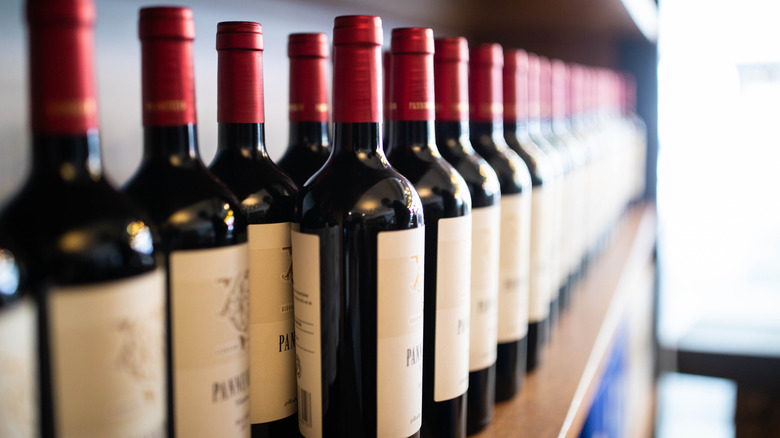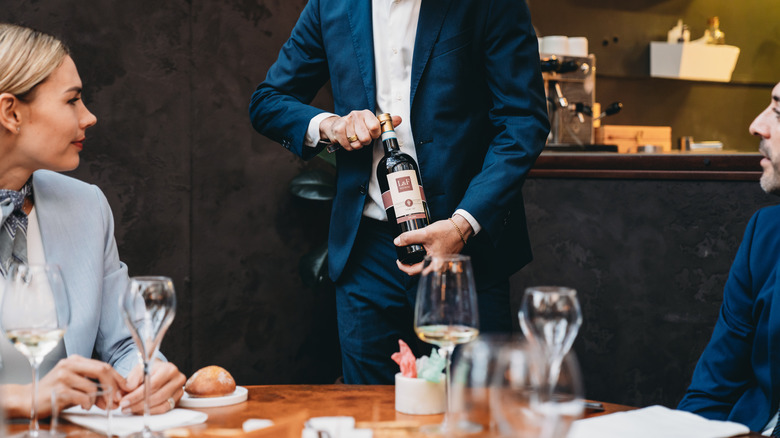How To Accurately Describe Your Wine Budget While Shopping
Frankly speaking, wine lists can be intimidating. Even if you're somewhat knowledgeable about wine, you generally need to be pretty thoroughly versed in viticulture to know about every varietal from every winery in every region that might appear on a wine list or on the shelves of a decent wine shop. And unless you're dealing with a pretty short wine list, it's not reasonable to just sit around Googling every bottle that piques your interest.
So, the best way to narrow down your options is to go in with a clear idea of how much you want to spend on your bottle(s). It'll narrow your options down, and it will substantially help any sommelier or shop assistant to pick out the right option for you.
The best move here is to be precise when it comes to price: Go for a nice, tidy price range — for example, $40 to $50. Or indicate that you want a bottle around a certain price point (say, around $50). Of course, you should check the wine list before you come up with a number: If there's very little (or nothing) in that range, you might need to broaden your scope a little. But otherwise, you're making life easier for both yourself and the service staff.
Vague price descriptions are the enemy
On the flip side, using vague adjectives to describe your wine budget is a recipe for miscommunication. Descriptions like "something affordable," "a mid-range bottle," or "at the fancy end" (or any phrases like these) are subjective. At an ultra-exclusive restaurant that routinely sells $400 bottles to wealthy customers, a sommelier could interpret "affordable" as "$200" since it's less than what many other people spend.
If you're at a small restaurant with a short wine list (say, 15 bottles), this probably won't lead to so much confusion — since there's likely a clearer "cheap" and "expensive" end of the wine list. But the wider the selection of wines, the more imperative it is to be clear about what you want to spend. And if you insist on using subjective descriptions for your price range, be sure to confirm the price of the bottle before you take it. If you decide to drink a bottle only to find out that it costs $100 more than you expected when the check comes, that's on you for not asking the price.
Even if you're using numbers, it's still important not to be too vague about it. Telling a sommelier that you're happy to spend anything up to $100 is probably not going to help a whole lot if there are 50 bottles under that limit (and it might encourage a sales-oriented sommelier to simply suggest one of the most expensive options in that range).
Know what else you want from your wine
When you're ordering or shopping for wine, don't forget that price isn't everything — after all, it would be strange if you go into a wine boutique planning to buy a Shiraz and walk away with a chardonnay that you don't even want because it was a touch cheaper.
To that end, just as you should go wine shopping with a clear idea of price, don't forget to formulate a clear idea of what else you want when ordering your wine. Ideally, that means going beyond simply knowing if you want red or white (or rosé, or orange). Which varietals do you (or don't you) want? Do you want it to be light or full-bodied? Fruity or mineral? Sweet or dry? Do you want organic wine? And do you want the wine to have other qualities to it, like oak or tannins?
Knowing the answers to these kinds of questions as well as your preferred price range will help a sommelier or wine seller find you the right bottle faster: The more details you can provide, the more satisfied you'll hopefully be with your wine purchase. If you have a specific wine you enjoyed in the past, never hesitate to mention it to your sommelier. This not only gives a price point, but it will help your host develop suggestions you might actually enjoy.



